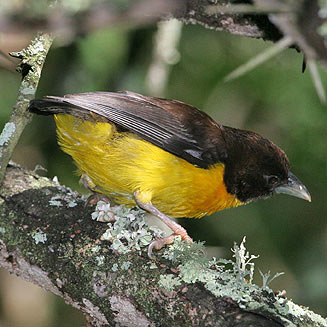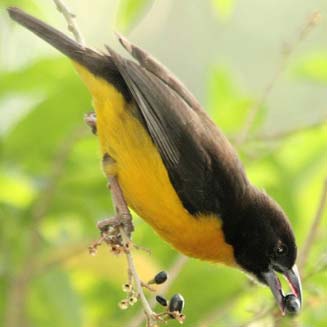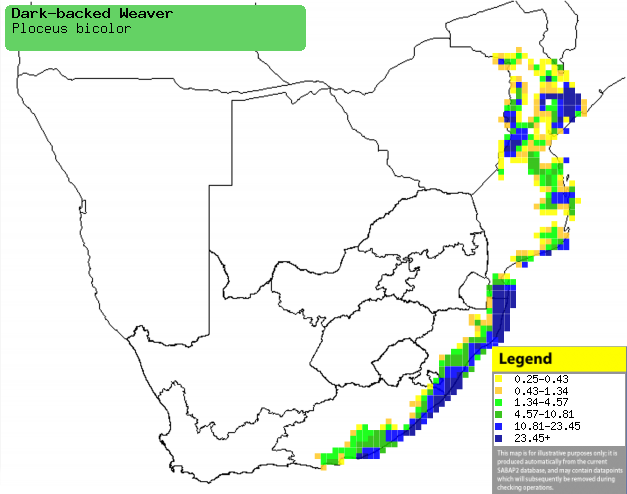|
Ploceus bicolor (Dark-backed
weaver , Forest weaver)
Bosmusikant [Afrikaans]; Ingilikingci [Xhosa];
iTilongo [Zulu]; Woudwever [Dutch]; Tisserin bicolore [French]; Waldweber
[German]; Tecel„o-das-florestas [Portuguese]
Life
> Eukaryotes >
Opisthokonta
> Metazoa (animals) >
Bilateria >
Deuterostomia > Chordata >
Craniata > Vertebrata (vertebrates) > Gnathostomata (jawed
vertebrates) > Teleostomi (teleost fish) > Osteichthyes (bony fish) > Class:
Sarcopterygii (lobe-finned
fish) > Stegocephalia (terrestrial
vertebrates) > Tetrapoda
(four-legged vertebrates) > Reptiliomorpha > Amniota >
Reptilia (reptiles) >
Romeriida > Diapsida > Archosauromorpha > Archosauria >
Dinosauria
(dinosaurs) > Saurischia > Theropoda (bipedal predatory dinosaurs) >
Coelurosauria > Maniraptora > Aves
(birds) >
Order: Passeriformes > Family: Ploceidae
> Genus: Ploceus
 |
 |
|
Dark-backed weaver,
Baviaanskloof Nature Reserve,
Eastern Cape, South Africa. [photo H. Robertson, Iziko ©] |
Dark-backed weaver feeding on fruit,
Pietermaritzburg, South Africa. [photo Alan Manson
©] |
For information about this species, see
www.birdforum.net/opus/Ploceus_bicolor Distribution and habitat
Occurs in patches from Cameroon and Somalia through
southern DRC, Zambia, Angola and Tanzania to southern Africa. Here it is common
from Mozambique and the extreme east of Zimbabwe to KwaZulu-Natal and the
Eastern Cape, generally favouring forest and dense riverine vegetation in
coastal thickets.
|
 |
|
Distribution of Dark-backed weaver in southern Africa,
based on statistical smoothing of the records from first SA Bird Atlas
Project (©
Animal Demography unit, University of
Cape Town; smoothing by Birgit Erni and Francesca Little). Colours range
from dark blue (most common) through to yellow (least common).
See here for the latest distribution
from the SABAP2. |
Predators and parasites
Nests are sometimes raided by snakes.
Food
It mainly eats arthropods supplemented with fruit, nectar
and flowers, doing most of its foraging in the canopy, gleaning from leaves and
branches. It often joins mixed-species foraging flocks, also hawking insects
aerially and plucking prey from the ground. The following food items have been recorded
in its diet:
- Arthropods
- Plants
- fruit
- nectar of Aloe
- flowers
- Tecoma capensis (Cape honeysuckle)
- Erythrina caffra (Coast coral-tree)
Breeding
- The nest is built by both sexes or just the male in about 7-9 days,
starting by weaving a simple ring which is extended into a retort shape,
with a long tunnel at a slight angle at the base. It is woven with stiff
material such as thin vines, creepers, Asparagus leaves and Russet
secamone (Secamone alpinii), while the interior is lined with softer
material, especially old-man's-beard lichen (Usnea). It is typically
attached to the tip of a branch or creeper, anywhere from 2-15 metres above
ground.
- Egg-laying season is from September-February, peaking from
November-December.
- It lays 2-4 eggs, which are incubated for about 15-17 days (recorded in
captivity).
- The chicks are fed by both parents, leaving the nest after about 22 days
(also in captivity), after which they may only become independent up to 6
weeks later.
Threats
Not threatened.
References
-
Hockey PAR, Dean WRJ and Ryan PG 2005. Roberts
- Birds of southern Africa, VIIth ed. The Trustees of the John Voelcker
Bird Book Fund, Cape Town.
|
